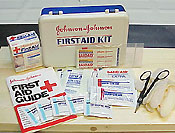This is a Veteran Owned site
NewWoodworker.com Safety SurveyExperience is not a protectorText and Photos by Tom Hintz Posted - November 2001 Note: This survey was done in fall of 2001. Despite the time passed, I have no reason to think any of the conclusions would be different today. This survey was posted hoping for a moderate number of responses. The woodworking community had other ideas, pelting my email box with brutally honest reports. It is apparent that a large percentage of woodworkers are decidedly secure people who, with few exceptions, selflessly described the cause of their accidents as their own stupidity, the exact word the majority used. The final survey count was reduced from 294 to 262 by eliminating accidental duplications, incomplete and frivolous (three) submissions. The rejection rate in this survey was exceptionally low compared to others I have conducted in the past. Table SawsFinding a large number of responses involving table saws in this survey was not completely unexpected, but the extent of their dominance was. Of the 262 submissions, nearly two thirds, (64-percent) focused on the table saw. Though kickback and related injuries are a common topic among woodworkers, actual contact with the blade caused the most injuries reported in this survey. Of 167 table saw reports, 113 of them (68-percent) involved the woodworker making contact with the spinning blade. Kickback was listed as the cause of injury in 48 reports (29-percent) followed by six others (4-percent) spread over various other incidents. A small number of the kickback occurrences also involved blade contact, but the woodworkers filing those reports considered the proximity of their hands to the blade the major cause of the injury, so those specific kickback incidents (3) were counted with the blade contact reports. Injuries attributed to equipment malfunction or design made up less than two percent of table saw reports. It should be noted that none of the equipment failure reports included evidence to support those claims or insinuated the problem resulted from something the manufacturer did. In nearly all cases, the woodworker assumed blame for their injury. Haste and fatigue were cited as contributing factors in eight percent of table saw injuries, but only two were blamed exclusively on either of these factors. The most-reported cause for table saw injury was the operator placing their hands too close to the blade, or reaching over it. Several involved trying to clear cutoffs from near the blade, but most blade contact injuries (76 percent of reports naming table saws) were described by the respondents as operator error. With the exception of a few pieces of wood that fractured and two cases of bolts loosening up (maintenance rather than failure issues) all of the table saw injuries were preventable according to those making the report. Descriptions of their own injury-producing actions included "arrogance," "inattentiveness," and "complacency." However, the words "dumb" and "stupidity" were used in 117 (73 percent) of the 167 table saw injury reports. Of the 48 kickback reports, 38 (79 percent) involved small work pieces. Most reports indicate the operator lost control of the piece. The second largest group of kickback respondents in one way or another lost control of the push stick, initiating the accident. Not having a splitter installed at the time of the accident was listed as a contributing factor in 11 (23 percent) of the kickback specific responses. RoutersThe next largest and only other statistically significant group of injury reports involved routers. Almost all of these 18 (7 percent) reports involved routers mounted in tables and injuries sustained making contact with the bit. As with table saws, these respondents nearly all took responsibility for making an error in procedure. The router injuries are equally divided between incidents where the material being routed was kicked out and those where the material otherwise made an unexpected movement that resulted in the operators hands contacting the rotating cutter. Three of the kickout reports indicated the operator sustaining injuries when the piece impacted their hands. Here again, the respondents indicated awareness that they were not using all appropriate safety procedures. Circle and Saber (Jig) SawsThe only other tools named in multiple responses were circle and hand-held jigsaws. Both drew fewer than ten responses. Though kickback was reported in a small number of circle saw reports, by far the dominant circumstance (88 percent of these responses) involved the blade contacting fingers that were beneath the work surface. Miscellaneous ToolsThe remaining responses named a wide range of power and hand tools, none of which totaled one percent of the survey total. Equipment such as hammers, chisels, belt sanders, lathes, grinders and jointers generated very small numbers of reports. Surprising in this group was only one injury report involving a radial arm saw. Age and ExperienceLogic might suggest inexperience fosters injury-producing mistakes, but that was not born out in this survey. Of the 262 respondents, only 113, (43 percent) reported less than five years of woodworking experience. The remaining responders (57 percent) reported woodworking experience averaging slightly over 18 years. The age group filing the fewest reports was 18-25, (4 percent) but that statistic is probably skewed by the small overall number of woodworkers in this age group. The next safest age group jumps to 56-65 (10 percent). The age group filing the most reports (32 percent) was 26-35. However, the remaining age groups were not far behind. Those in the 46-55 range made up 29 percent of the survey and reports from the 36-45 range brought 25 percent. Though we might think woodworkers are most apt to sustain an injury in the early stages of their woodworking experience, the average date of injury was only 2.5 years ago. The average woodworking experience reported was 11 years. That means the woodworkers in this survey worked 8.5 years before suffering the injury. Injury SeverityFortunately, the vast majority of the injuries reported were relatively minor cuts, most (88 percent) requiring only home first aid. The remaining reports indicated either visiting their doctor's office or the emergency room for treatment. The average number of missed work days came in at 3.5. Surprisingly, there were only two reports of amputation. The most severe, the partial loss of a thumb and forefinger occurred while using a table saw and fence combination commonly regarded as the best available. One mans report, now that we know he is fine, is a bit funny. In his own words he wrote, "I was ripping a narrow piece of pine about two feet long, without a push stick. As the wood was going through the blade I was watching the far end to keep it against the fence and ran my thumb into the blade, cutting ¼-inch off the tip. When I felt the blade hit my finger I jerked my hand out, clutched it with my other hand and started to jump up and down just as the saw fired the wood my way, striking me squarely in the privates." He stated later in his report that he has recovered fully, uses a push stick at all times and stands to the side of the fence, at all times. ConclusionsIn general, this survey indicates woodworkers pursue this hobby in a very safe manner despite the potential for injury inherent in equipment capable of cutting and shaping the toughest of woods. The companies that design and build woodworking equipment get a huge vote of confidence by the virtual total absence of blame assigned to their products in the reports. However, not all is rosy in woodworking land. The overwhelming suggestion of this survey is there appears to be a significant number of woodworkers are operating their machinery and tools unsafely; and know it. This is not a statistical assumption, the woodworkers themselves repeatedly said things like, "I knew I should not have been doing that." In nearly all cases, they bluntly describe their injury-producing actions as "stupid," the word actually used most often by the respondents themselves. It is also evident that push sticks and similar safety devices are not being used as often as they should be amongst this group of woodworkers, and I suspect far too many others. By the respondents own descriptions, most had a very good chance of avoiding the injury they sustained if their hands had been grasping the handle of a push stick rather than the workpiece itself. The fact so many injury reports indicated several years of experience before sustaining the injury suggests complacency is a contributing factor. Several respondents specifically related having performed the same procedure which caused their injury many times before having an accident. Certainly, this survey does not suggest all woodworkers are disregarding safe operating procedures. Many, if not most, are careful when operating their tools and use the appropriate safety devices to help prevent or minimize an injury should something go wrong. What this survey does suggest is that we need to guard against falling into the trap of complacency, as did nearly all of those reporting injuries. We need to look at the procedures we are using right now to see if there are ways to improve our safety. It is important to remember that most of the woodworkers who reported injuries had operated their equipment for long periods of time before the accident occurred. Then, it was too late. Do you have a comment about this page? - Email Me!
|
All written, photographic and drawn materials are property of and copyright by NewWoodworker.com LLC 2000-2019. Materials may not be used in any way without the written permission of the owner.


